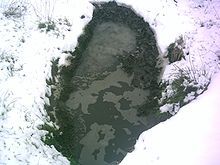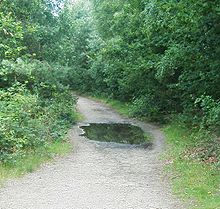Puddle
![]()
This article or subsequent section is not sufficiently supported by evidence (e.g., anecdotal evidence). Information without sufficient evidence may be removed in the near future. Please help Wikipedia by researching the information and adding good supporting evidence.
![]()
The title of this article is ambiguous. For other meanings, see Puddle (disambiguation).
A puddle, also puddle (Austrian Lacke, Low German also partly Lusche, Palatine among others Latsche, Swiss German Glungge or Gunte), is an accumulation of liquids - mostly water - on the surface of the earth, which forms e.g. after a rain and seeps away or evaporates a few days later. Puddles form the smallest form of still water.
The word Pfütze (ahd. pfuzza, puzza; ndd. Putte; ndl. put) is borrowed from the Latin puteus for "pit, well".
For individual traffic (e.g. pedestrians), puddles on traffic routes are considered a nuisance. For this reason, paths are paved or asphalted wherever possible. In green areas, such as lawns and pastures, efforts are also made to level depressions as well as small elevations. For children, puddles offer opportunities for play.
Ecologically, water puddles are temporary microbiotopes. Antoni van Leeuwenhoek discovered around 1668 that puddles contain life on a microscopic scale. For many small creatures, such as insects, depressions provide coolness, moisture, and water, while elevations provide more sunlight and a few degrees Celsius more warmth. In deeper forest puddles, amphibians and newts in particular thrive or rest on their migrations. The natterjack toad needs puddles with little vegetation, e.g. in gravel pits, to reproduce. For birds, puddles provide drinking and bathing opportunities. Swallows use moist clay from puddles to build their nests. One reason for the decline of the barn swallow is also the disappearance of puddles from the landscape, which was carried out by the expansion of agricultural roads (farm tracks) within the framework of the European Union's agricultural structure promotion or measures of collectivization.
Puddles tend to become larger and more permanent (self-reinforcing). The stagnant water softens the ground, muddy water is splashed when driving through the puddle and coarser components of the ground remain in the surrounding area. The puddle becomes deeper and larger. In addition, fine clay particles flow back into the puddle with the water and seal it more and more towards the subsoil, so that the water in the puddle can hardly seep away.

Winter Puddle

Puddle on a path
Search within the encyclopedia